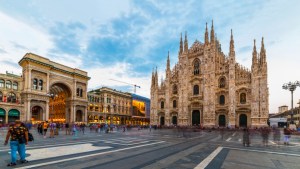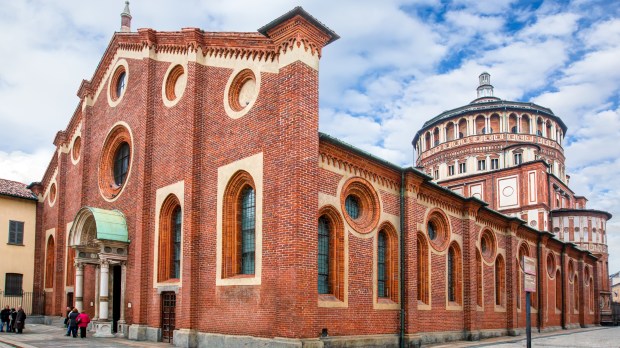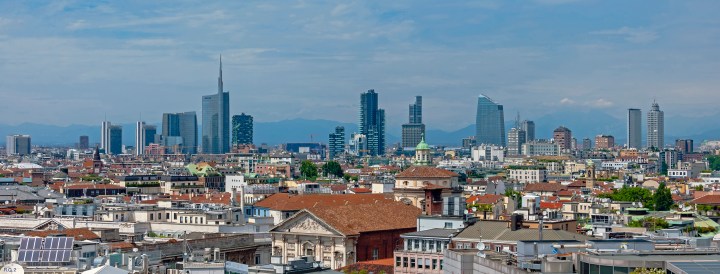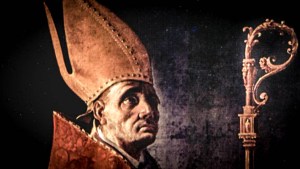“The Church of the Lord is built upon the rock of the apostles among so many dangers in the world; it therefore remains unmoved.”
St. Ambrose
This is the second of two articles on a walking pilgrimage in Milan, Italy.
Italy’s second most populous city, after Rome, is Milan. It is a world-class city renowned for art, fashion, design, education, and media. Known as one of the “Four Motors for Europe,” it is an important financial hub.
Milan’s rich Catholic history
At the same time, Milan has a long religious tradition. St. Ambrose, who served as Archbishop of Milan from 374 until his death in 397, is considered one of the most influential ecclesiastical figures of the entire patristic period. He is one of four Latin Fathers and Doctors of the Church.
Another Father and Doctor of the Church, St. Augustine, converted to the faith after listening to St. Ambrose’s sermons. He was baptized by St. Ambrose on Easter Vigil in 387 in Milan’s cathedral.
Further accentuating its importance, is Milan’s own Ambrosian Rite – one of the few liturgical rites in the western Catholic world distinct from the ordinary Roman rite.
St. Ambrose – Milan’s most preeminent Catholic – is not buried in Milan’s famous Duomo, but in a church built and consecrated by him in 387: the Basilica of St. Ambrose.
When St. Ambrose arrived in Milan, there were clashes among the local churches between adherents of Arianism and those who followed the Nicene Creed.
Ambrose was a staunch supporter of the Council of Nicea that taught that Christ, the Son of God, was “begotten, not made, consubstantial with the Father.” In sermons, Ambrose railed against Arianism, which held that Christ was not co-eternal with God the Father and was, subsequently, distinct from and subordinate to the Father.
Another means he used to combat Arian heresy and bolster orthodox teaching was through construction. He built three (or possibly four) churches outside the city, all embellished with anti-Arian and pro-Nicene symbolism.
They are the Basilica Apostolorum (the Basilica of the Apostles, now San Nazaro in Brolo), the Basilica Virginum (the Basilica of the Virgins, now San Simpliciano), and the Basilica Martyrum (the Basilica of the Martyrs, later renamed in his honor). A fourth church, Basilica Salvatoris (the Basilica of the Savior, now San Dionigi) is also attributed to him, but may be from a later century.
The Basilica of St. Ambrose
The Basilica of St. Ambrose was built in an area where numerous Roman martyrs had been buried, hence its original name. Noted for its rich medieval architecture and religious treasures it was rebuilt in the 11th century and became the model for all Romanesque churches throughout Lombardy.
The basilica is located adjacent to one of Europe’s most renowned Catholic Universities, Sacro Cuore. The remains of St. Ambrose can be visited in the crypt.
‘The Last Supper’
Next, a short walk from St. Ambrose is one of the world’s most recognizable paintings: The Last Supper. Painted by Leonardo da Vinci between 1495-1497, the famous mural was commissioned for the refectory in Santa Maria delle Grazie. Originally built as a church and Dominican convent by the Duke of Milan, Francesco I Sforza, today it is a museum and UNESCO World Heritage Site.
The painting depicts the reaction of the disciples during the Last Supper just after Christ announced that one of them would betray him. Judas is seated in the grouping of three figures to the right of Christ between St. John and St. Peter.
Peter holds a knife in his right hand and touches John on the shoulder with his left. His body is stretched out, and his face betrays intense emotion, perhaps anger. John is depicted as a young man. He appears to faint, or swoon, desolate at the horrific news.
Judas, on the other hand, is different from all the other disciples. He is depicted smaller, lower, and darker. He is holding a small bag in his right hand, which represents the silver coins given to him to betray Jesus. With his left hand, he is tipping over the salt cellar, a gesture indicating the betrayal of one’s master.
While at Santa Maria delle Grazie, visitors should not overlook a miraculous image of Our Lady credited for having protected Milan against numerous plagues. (Renewed prayers here in our own day would perhaps be beneficial.)
When not under lockdown, visits to Santa Maria delle Grazie must be reserved in advance online at: https://cenacolovinciano.org/en/
The Ambrosian Library
On the other side of Milan, near the Duomo, is the Biblioteca Ambrosian (the Ambrosian Library). One of the great repositories of European culture, it was founded by Cardinal Federico Borromeo, the cousin of St. Charles Borromeo.
The collection boasts more than 30,000 manuscripts and includes a 5th-century illustrated Iliad, early editions of Dante’s Divine Comedy (1353), and the Muratorian Canon (170 AD) – the earliest example of an authoritative list of biblical books. It contains twelve manuscripts of Leonardo da Vinci, as well as some 12,000 drawings by artists from the 14th through the 19th centuries.
Milan’s oldest church
Time permitting, other sites to visit include the Church of San Lorenzo Maggiore. Built in the 4th century, San Lorenzo Maggiore is Milan’s oldest church. Adorned with mosaics that seem more befitting of one of Ravenna’s Byzantine churches, San Lorenzo recalls the era when Milan was the capital of the Western Roman Empire.
Also noteworthy church in Milan is the Church of San Satiro. Built in 876 over the house of St. Satyrus, the brother of St. Ambrose, it became an important pilgrimage site in the High Middle Ages due to a miraculous image of the Virgin Mary. Its architecture was designed by the Renaissance artist and architect, Bramante (1444-1514), and is noted for its classical sense of proportion and perspective.
Finally, popular non-religious sites in Milan include Milan’s Galleria, adjacent to the Duomo, known for its top brand fashion stores; the Palazzo reale, or royal Palace, near the Duomo; the Sforzesco Castle; and La Scala Theatre, one of the most renowned opera houses in the world.




